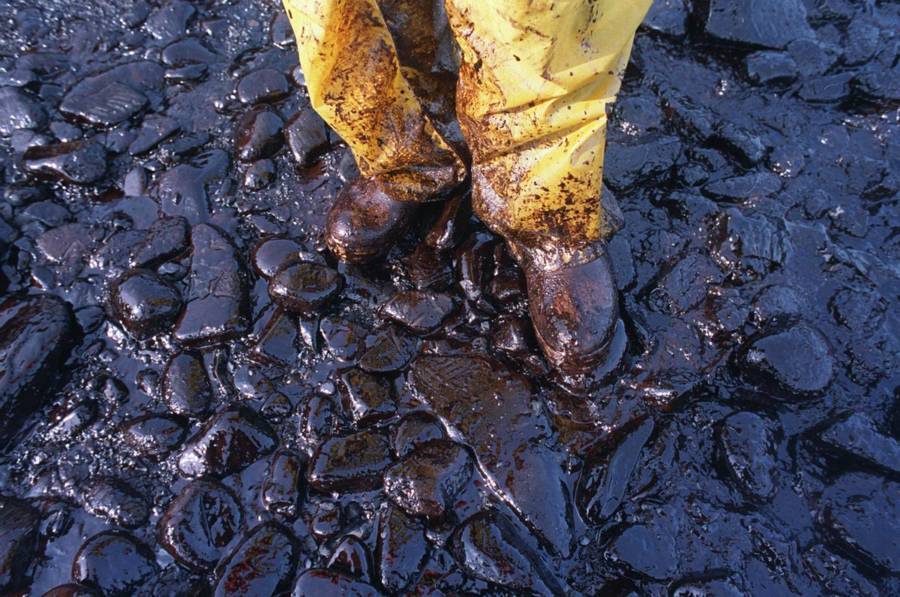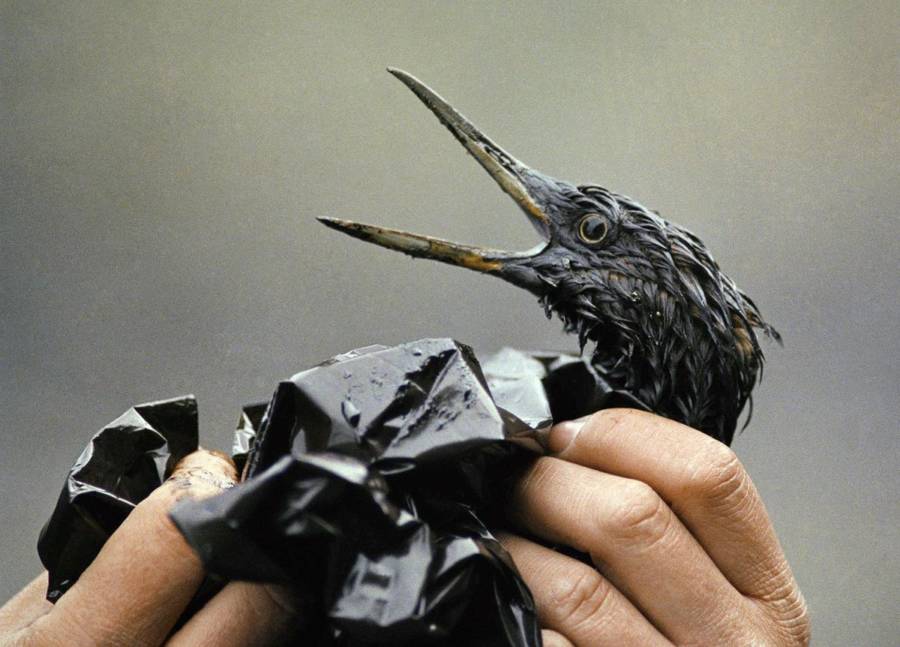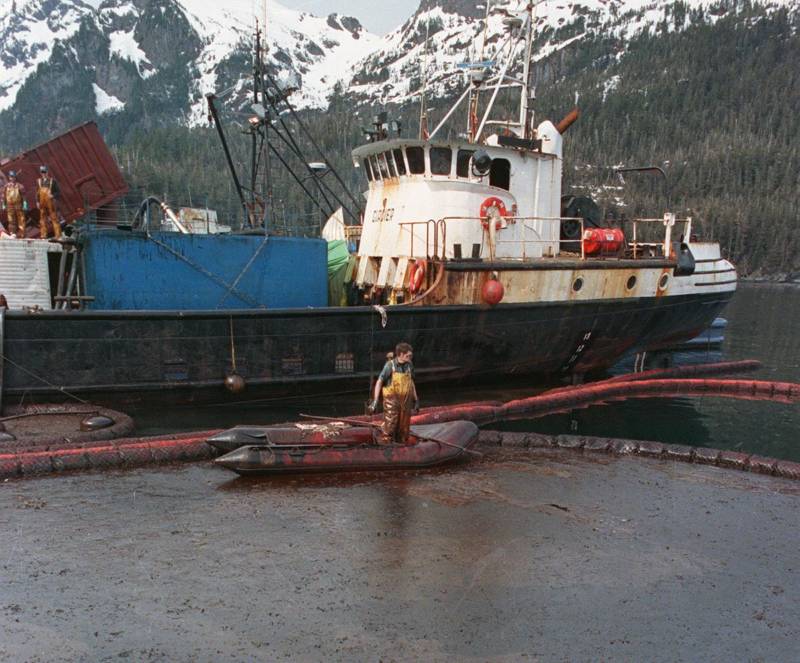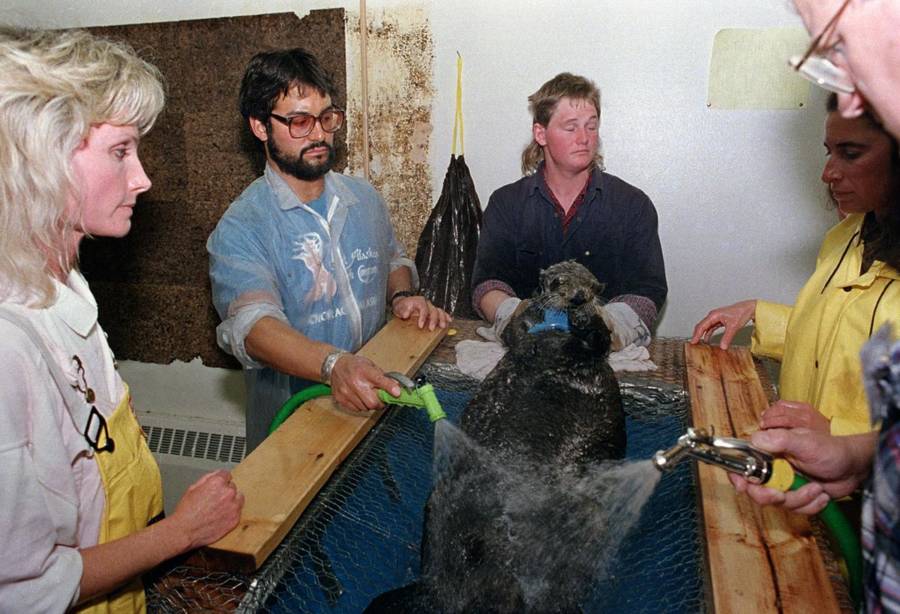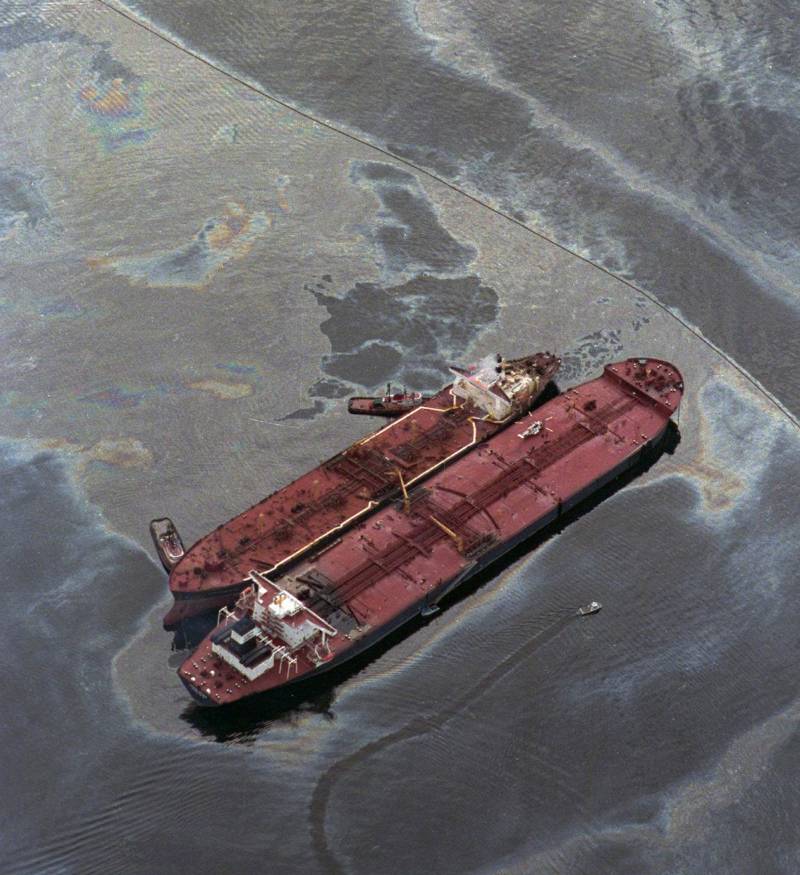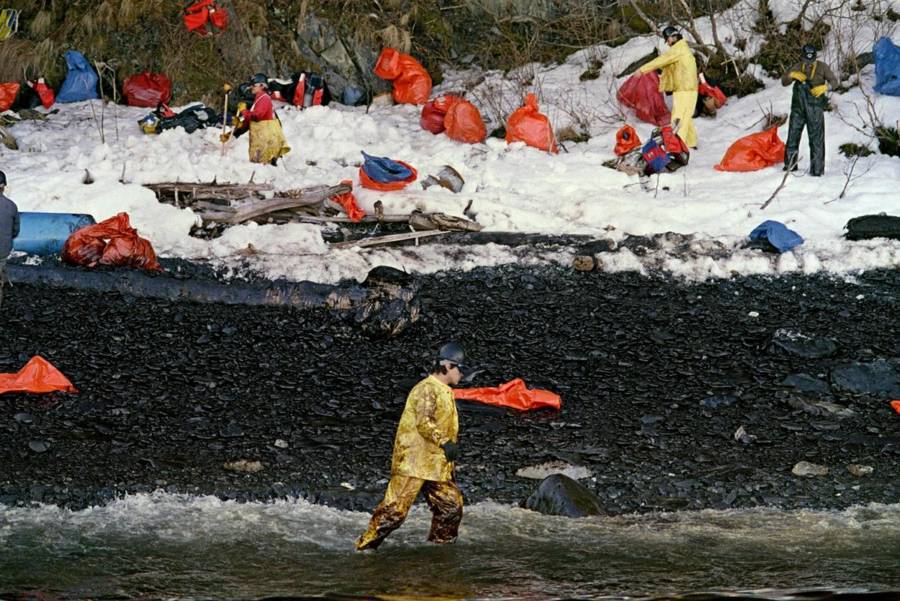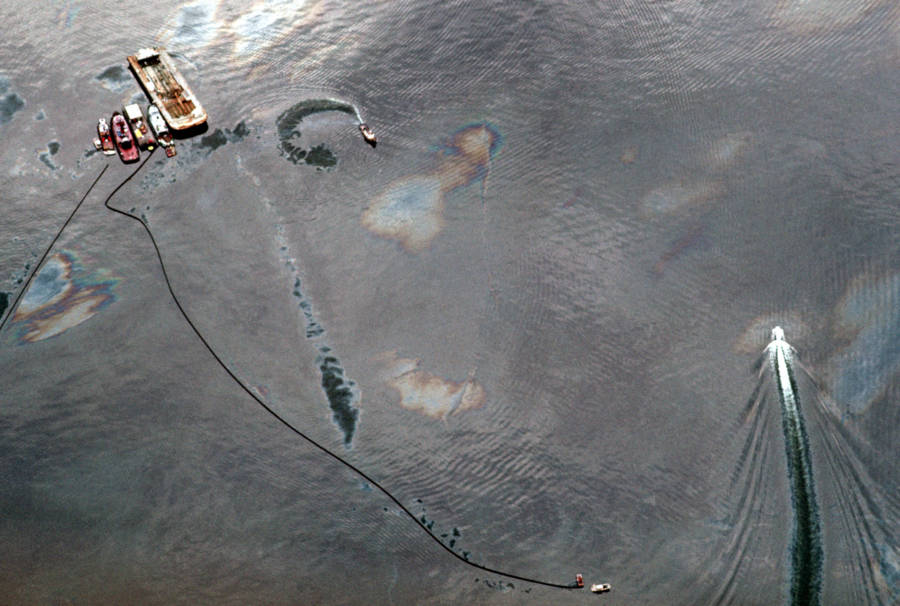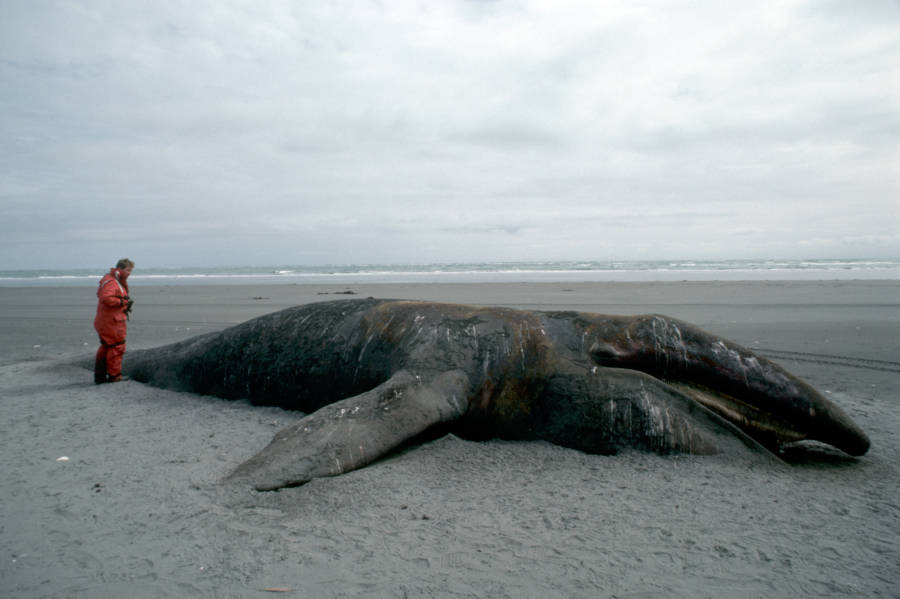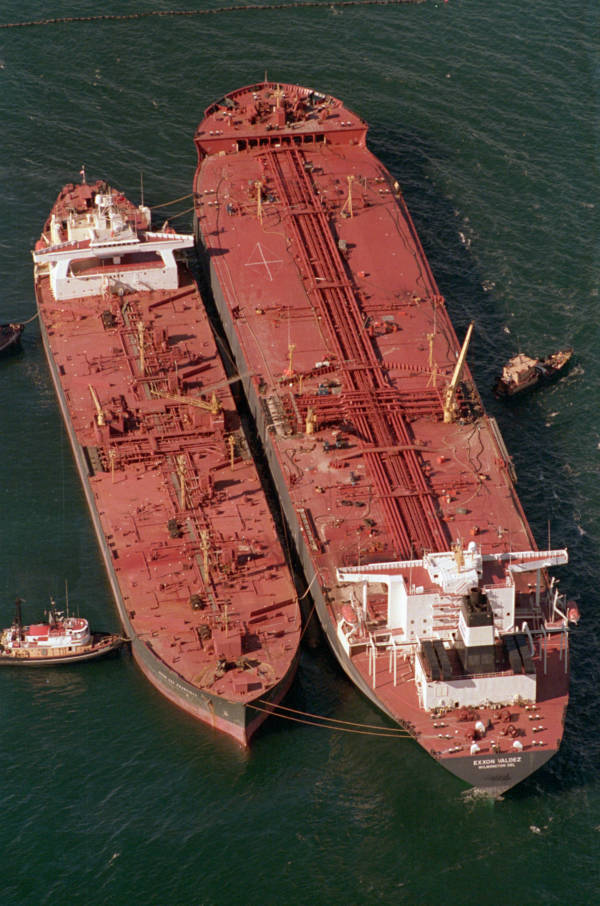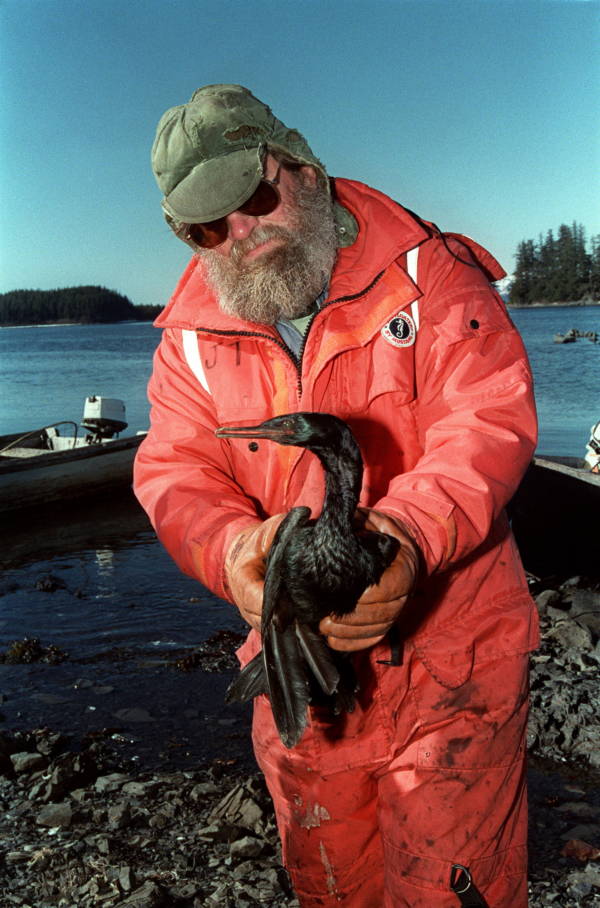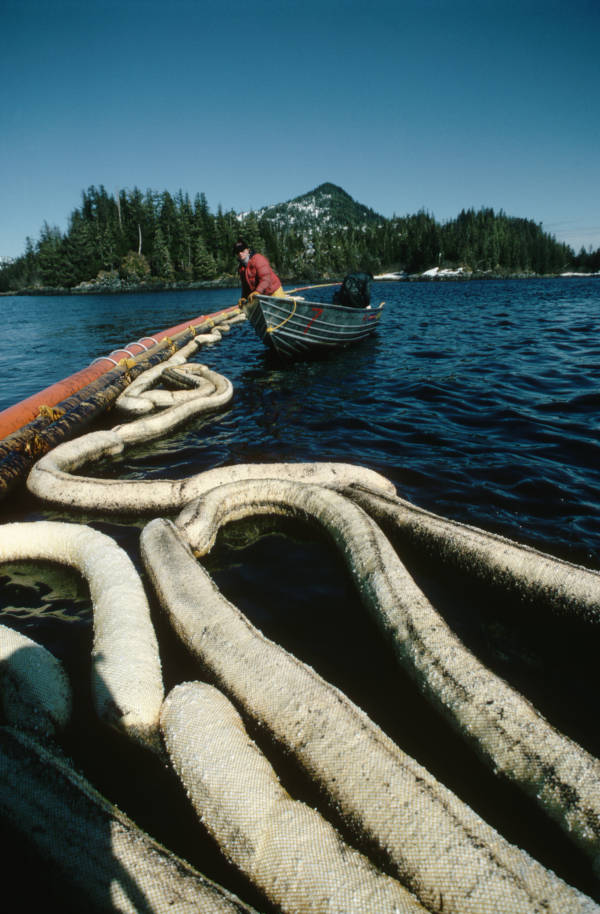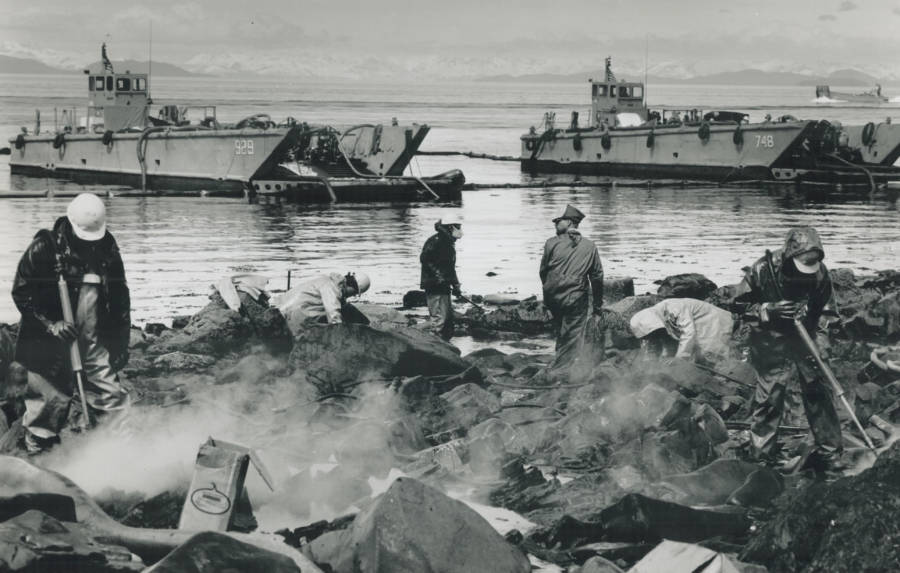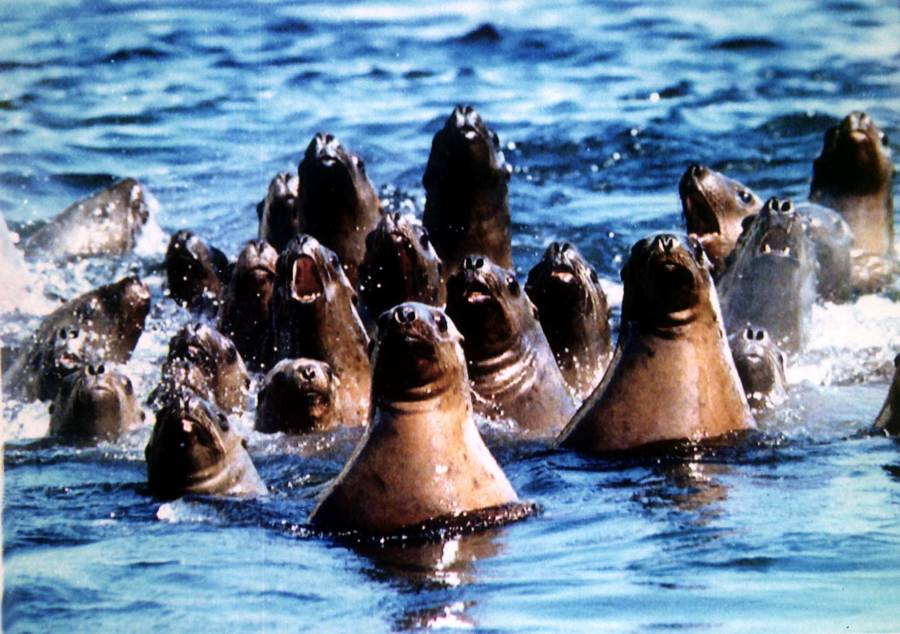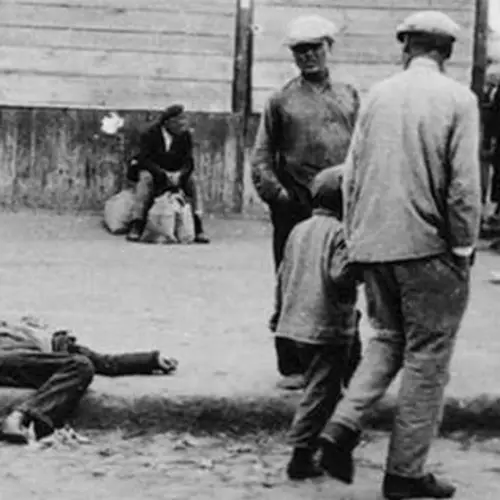After the Exxon Valdez tanker crashed into a reef, 11 million gallons of crude oil spilled across 1,000 miles of Alaskan coastline.
Thirty years ago, the hull of the Exxon Valdez cracked open after the oil tanker hit an Alaskan reef. Eleven million gallons of oil spilled into the Prince William Sound — the equivalent to nearly 17 Olympic-sized swimming pools — polluting the area's clean waters with oil and exposing its marine ecosystem to toxic chemicals.
Exxon spent nearly $4 billion after the horrific incident to pay for cleanup efforts, compensations for affected victims, and campaigns to rehabilitate the company's image, which had been tarnished by media reports of wildlife soaked in oil from the spill. The toxic spill killed hundreds of thousands of animals.
The Night Of The Exxon Valdez Oil Spill
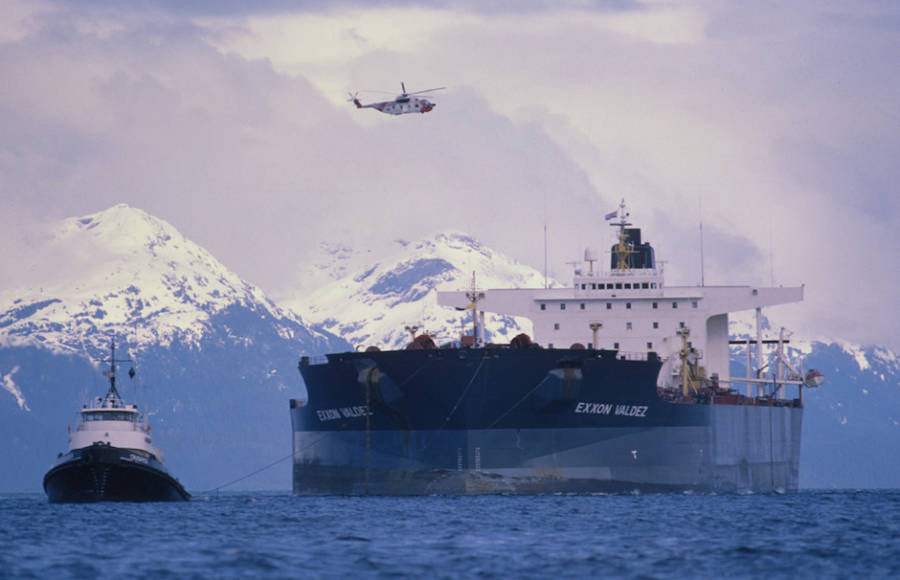
Erik Hill/Anchorage Daily News/MCTThe Exxon Valdez is re-floated and towed away by a small ship from Bligh Reef.
On March 24, 1989, the Exxon Valdez tanker was sailing along the coast of the Prince William Sound in Alaska on its way to Long Beach, California. At four minutes after midnight, the hull of the ship burst open after the tanker collided with Bligh Reef, spilling crude oil into the area's open waters.
Captain Joseph Hazelwood left the bridge just 10 minutes before the crash; he put Third Mate Gregory Cousins in charge of steering the tanker.
According to later reports, Hazelwood had decided to divert the Exxon Valdez tanker out of the official shipping lanes to avoid colliding with small icebergs scattered in its path. Official protocol was to slow down and navigate carefully through the route, but not wanting to risk losing precious time to reach their destination, Hazelwood steered the tanker out of the proper lanes.
Not long after the ship changed course, Hazelwood left his post to return to his quarters. According to Cousins, Hazelwood said he'd be gone for "just a few minutes." He left Cousins in charge with a helmsman, Robert Kagan — even though Cousins wasn't licensed to operate a ship in that area — and ordered him to steer the tanker around the ice.
In court testimony, Cousins claimed he had given the correct orders to Kagan, but that Kagan didn't carry them out properly. He called the captain at 11:55 p.m. to say he was beginning the turn to avoid the reef, but moments later phoned him again to say, "I think we're in serious trouble."
Before he knew it, it was too late to avoid collision with Bligh Reef. The thin layer of the Exxon Valdez tanker body suffered too much damage from the hit to hold up and its crude oil cargo spilled into the water.
Irreparable Damage To Alaska's Environment
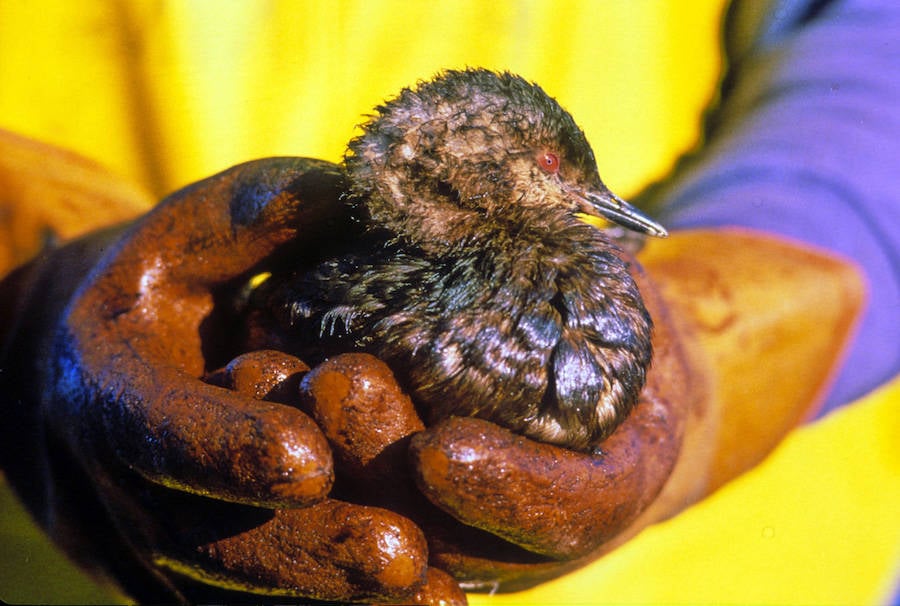
Bob Hallinen/Anchorage Daily News/TNSWorkers recover and clean birds soiled by crude oil.
The Exxon Valdez tanker was a single-hull ship with eight of its 11 cargo tanks ruptured, releasing an unthinkable amount of crude oil into the sea.
As soon as the oil began spilling into the water, there was no time to waste to prevent it from spreading, but oil companies were slow to respond. President George H. W. Bush initially refused to help clean up what he saw as Exxon's mess.
"We're nine hours after the wreck, and there was not a speck of promised recovery equipment on the water," marine toxicologist and activist Riki Ott said in an interview with the New York Times. "This had all been promised within six hours, and we were three hours past six hours, and nothing."
Chaos ensued as neither Exxon Shipping nor the Alyeska Pipeline Company reacted swiftly enough to mitigate further damage from the oil spill. Residents of Prince William Sound's small community and coastal workers were in shock, ill-equipped and untrained to handle an emergency of such magnitude. A storm swept in soon after the spill, spreading oil across 1,000 miles of coastline.
Eight years prior, the oil industry had decided to disband their 20-member emergency team that would have responded to oil spills in the Prince William Sound and Valdez Harbor. Emergency response vessels were also unavailable, either covered in deep snow or undergoing repairs.
A controversial method that was used by the companies to clean up the Exxon Valdez oil spill was to use chemical dispersants, which theoretically would break down the oil and, therefore, allow the substance to dissolve into the water. But this method was highly contested by environmentalists who contended that the dispersants were more toxic to humans and animals than the oil alone.
Aerial footage of the spill was alarming and showed just how widespread the incident had become with much of the crude oil having washed ashore, covering the sandy beaches in a black shiny coat. Sea birds and sea lions struggled to swim in the oily slick as the once clear Alaskan waters were engulfed in the thick black substance.
Cleanup workers and environmentalists began hauling out bodies of animals that were either dead or severely covered in oil. Various sea birds, otters, fish, sea lions, and other marine life had fallen victim to the 11 million gallons of crude oil that leaked into the sea.
The Federal Government Launches An Investigation
The federal government kicked off an official investigation under the National Transportation Safety Board, wherein some key details were discovered in relation to the oil disaster. One of the first revelations to come out of the investigation was that Captain Hazelwood, who was essentially in charge of the Exxon Valdez tanker, had a history of drinking.
Some crew members claimed that the captain had a few drinks at the bar earlier that day. The wife of a crew member said that she saw Hazelwood drinking around 2 p.m., while others said that they had caught the stench of alcohol on his breath the morning after the oil spill. Tests revealed his blood alcohol content the night of the spill was above the Coast Guard's legal limit.
Although witnesses pointed to signs of drinking, nobody could confidently state that the captain had appeared to be inebriated.
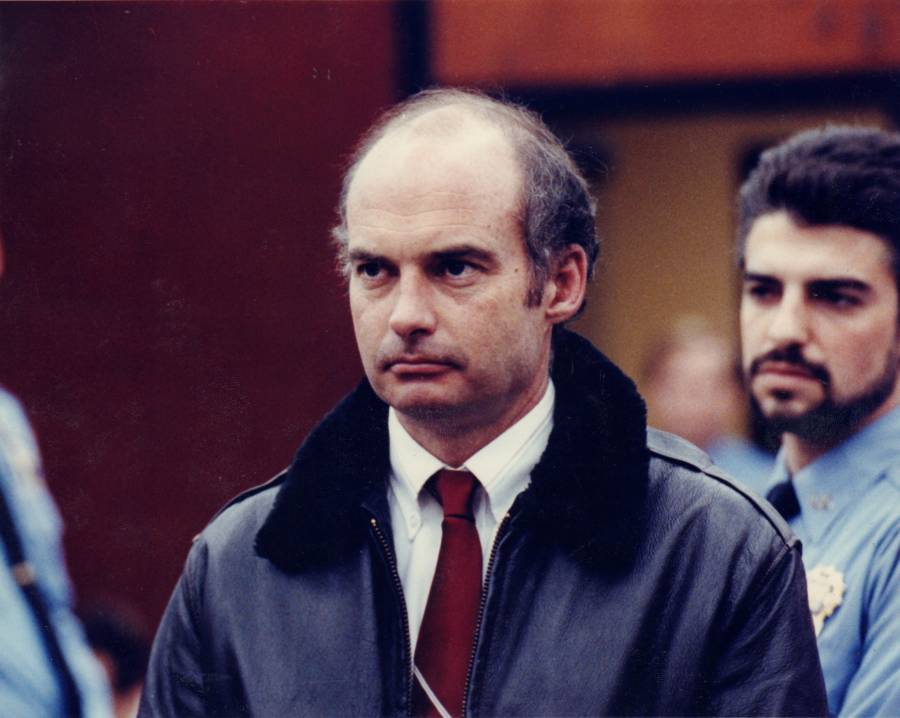
GettyCaptain Joseph Hazelwood appears in court two weeks after the oil spill.
Probes also revealed that the Exxon had cut production measures, which likely led to overworked staff, including Third Mate Gregory Cousins, who had been at the helm at the time of the Exxon Valdez crash. Cousins had offered to work past midnight that night as a favor to a friend. But both Cousins and Exxon denied that the crew member had been overburdened with work.
Hazelwood was acquitted of all but one misdemeanor: negligent discharge of oil. He was sentenced to 1,000 hours of community service cleaning around Prince William Sound and fined $50,000. Charges of misconduct and intoxication against Hazelwood were ultimately dismissed, but his captain’s license was suspended for nine months.
Many saw his sentence as a slap on the wrist compared to the damage his negligence had caused Alaska's environment, wildlife, and inhabitants.
The Exxon Valdez Oil Spill Was A Real Life Horror
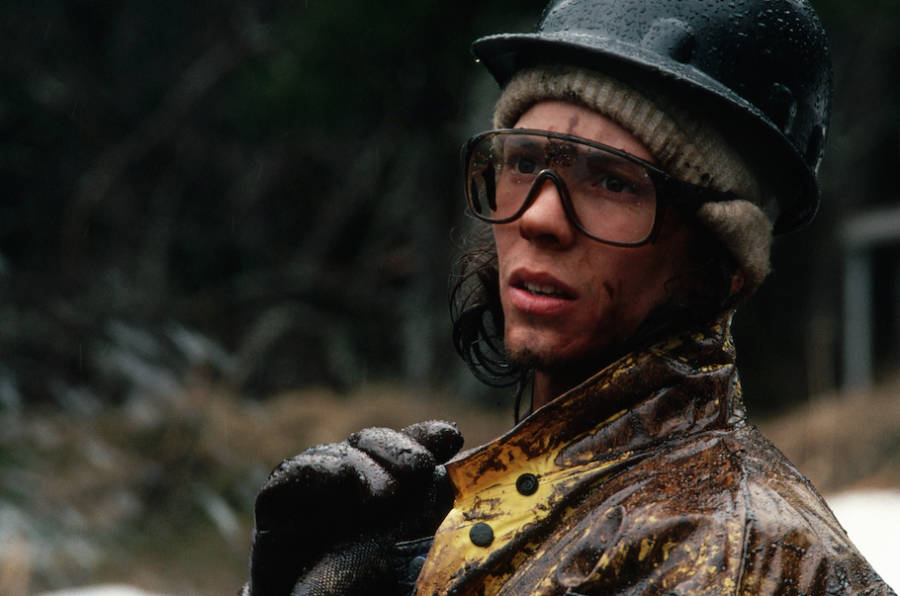
Natalie Fobes/CORBIS/Corbis/ Getty ImagesA woman helps in the cleanup effort on Green Island, Alaska. Cleanup operations lasted months after the spill.
Regardless of what may have transpired that night, the harm from the Exxon Valdez oil spill was irrefutably catastrophic. One local fisherman described the ordeal as "a horror movie in your mind."
Oil from the tanker spill killed an estimated 250,000 seabirds, 2,800 sea otters, 300 seals, 250 bald eagles, 22 killer whales and billions of salmon and herring eggs. And it tanked the local community's economy. Many seafood workers went bankrupt after the oil spill devastated the Prince William Sound's fish population.
Exxon would be made to pay, literally, for damages caused by the Exxon Valdez oil spill. The company spent $2 billion on cleanup operations, and another $1.8 billion on habitat restoration and personal damages. The federal government and the state of Alaska reached a $900 million with Exxon in 1991.
But it took decades to get the company to pay punitive damages. An Alaskan court ordered Exxon to pay $5 billion in 1994, but but after 14 years of lawsuits and appeals, the U.S. Supreme Court settled on about $500 million. Exxon made about 90 times that amount in profit in 2008.
Environmental Protections Remain Largely Unchanged Since The Exxon Valdez Oil Spill

Bob Hallinen/Anchorage Daily News/MCTExxon Valdez oil spill workers use pressure washers to wash oil from the beach at Smith Island, Alaska.
But if there is one silver lining from the Exxon Valdez oil spill, it is that the federal government finally took action to beef up legislation for environmental protections.
A year after the incident, Congress passed the Oil Pollution Act of 1990. The legislation increased penalties for companies responsible for oil spills and required that all oil tankers operating in U.S. waters have a double hull instead of a single hull, like the Exxon Valdez had, in order to reduce the risk of marine pollution in the event of a collision. Oil companies were also pressured to strengthen internal safety measures and emergency plans.
Unfortunately, though, all that focus on environmental protections quickly faded. By the time the BP-contracted Deepwater Horizon oil rig exploded and leaked in the Gulf of Mexico in 2010, not much had changed in the way of emergency response. The explosion released as many as 210 million gallons of crude oil into the Gulf of Mexico — the largest marine oil spill in history.
The Exxon Valdez oil spill may have happened 30 years ago, but its effects on Alaska's ecosystem and communities are still very current.
Next, check out photos of Whittier, Alaska, the tiny town that exists almost entirely under one roof. And then, see how real California's pollution problem is with 31 shocking images.


